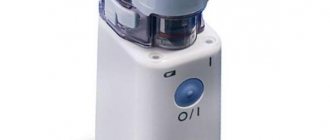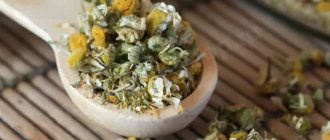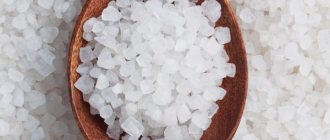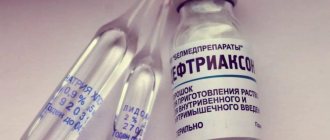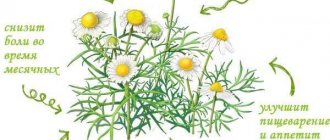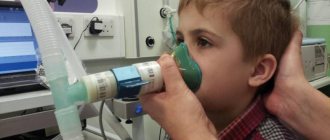What is an inhalation nebulizer?
Reference! A nebulizer is a device that allows you to convert a drug into fine particles, which are then inhaled through a mask or a special attachment - a mouthpiece, reaching deep into the respiratory organs.
The first nebulizers were invented about a hundred years ago.
During their existence, they have established themselves as effective means in the treatment of various diseases of the respiratory system.
Today they are successfully used in treatment not only in medical hospitals, but also privately.
For bronchitis, inhalations based on medications and special solutions are used.
Do not use homemade solutions in nebulizers: herbal infusions, decoctions of medicinal plants, etc.
Note! Products used for inhalation should only be manufactured in pharmacies. Also, all kinds of oil compositions are not suitable for devices of this type.
How will inhalations help?
The main problem of patients with obstructive bronchitis is small and large air ducts clogged with mucus. The goal of treatment with medications and folk remedies is to relieve spasm of smooth muscles to free the bronchi from phlegm.
Administration of drugs by inhalation has an undoubted advantage compared to taking capsules or tablets.
Oral medications are absorbed in the intestine, as a result of which up to 50% of the drug substance is lost. When treated with inhalers, the medicine completely enters the respiratory tract and is absorbed 20 times faster.
During inhalation, the medicine reaches its maximum concentration in the area where bacteria multiply.
Inhalations have the following effect on the bronchi:
- reduce swelling and inflammation;
- relieve spasm of smooth muscles;
- stimulate the removal of mucus from the airways.
After the first procedure, the patient feels easier breathing due to the expansion of the bronchial lumens. The number and duration of coughing attacks decreases.
The advantage of the device is that it is impossible to overdose on the drug and there are no side effects.
Benefits of a nebulizer in the treatment of bronchitis
The undoubted advantages of using a nebulizer for inhalation include the following:
- Medicines are transported directly to the diseased organ without entering the bloodstream. This method of delivering therapeutic components significantly reduces the likelihood of side effects .
- Finely dispersed fractions of drugs are optimal for absorption by the organs of the respiratory system. Using a nebulizer, particles of the sprayed substance are delivered even to small bronchi and alveoli .
- Bypassing the digestive tract, medicinal substances are not destroyed and do not undergo changes.
- Quickly relieve swelling and improve the condition of the mucous membrane of the respiratory system.
- Economical use of drugs.
- Possibility of using the drug for children , starting from birth, and elderly people.
- Comfortable procedures . Inhalations can be carried out even while you sleep.
Inhalation with a nebulizer for bronchitis
How to do inhalations for bronchitis? It is best to use nebulizers, which create aerosols of drugs without increasing the temperature of the solution. There are different models of such devices, differing in the size of particles in the aerosol cloud:
- Medium-fine aerosol - it is used for inhalation for bronchitis, bronchial asthma, and for the treatment of pneumonia. The particle size is 2-4 microns, they are able to penetrate deeply into the lower respiratory tract without lingering in the upper.
- Coarse aerosol - used for tracheitis, laryngitis, for the treatment of runny nose and pharyngitis. The particle size is 5-20 microns, so they do not penetrate into the deep parts of the respiratory system, but concentrate on the mucous membranes of the upper tract - trachea, nose, pharynx.
Today, ready-made dosage forms have proven themselves well, which are convenient to use for inhalation for laryngitis or bronchitis independently at home on the recommendation of a doctor, if you have a home inhaler. Such means include:
- Inhalations with Lazalvan (Ambroxol) and Ambrobene
Lazolvan is a very effective remedy, which contains Ambroxol hydrochloride; it helps to liquefy sputum, making it less viscous, which helps the bronchial mucosa get rid of it more quickly.
They are used for acute and chronic bronchitis for inhalation, for children over 6 years old and adults, 3 ml for each inhalation 2 times a day, for children 2 - 6 years old, 2 ml of solution, for children under 2 years old, 1 ml.
To create an inhalation solution, the drug is diluted with saline solution 1/1, such inhalations cannot be done for more than 5 days, and also combined with taking antitussive drugs - Libexin, Codeine, Sinecode - instructions, Bronholitin, etc. The use of Ambroxol is more effective than Ambrobene, and both drugs improve the absorption of antibiotics.
- Mineral water inhalation
Slightly alkaline waters, such as Borjomi and Narzan, moisturize the mucous membrane of the respiratory tract from the oropharynx to the smallest bronchi, dilute bronchial secretions and soften catarrhal phenomena, so they are good to use for inhalation for bronchitis for both children and adults. To make 1 inhalation you will need 4 ml of non-carbonated mineral water; you can do the procedure 4 times a day.
- Inhalation of ACC injection and Fluimucil
It is used when there is a violation of the discharge of sputum from the lower respiratory tract, to facilitate the discharge of mucous secretions in the upper respiratory tract. Dosage for children 2-6 years old 1-2 ml. 1-2 r/day, children 6-12 years old - 2 ml., over 12 years old and adults 3 ml of ACC solution per 1 inhalation, also 2 times a day. The drug should be diluted 1/1 with saline solution, inhalations should be done for no more than 10 days.
- Inhalation with chlorophyllipt
To inhale with this drug, use its 1% solution and dilute it 1/10 with saline. This is an extract of eucalyptus that has unique antiseptic properties. For inhalation take 3 ml. diluted solution, do inhalations 3 times a day.
- Inhalation with Rotokan
This is an anti-inflammatory drug, based on extracts of chamomile, calendula and yarrow, used as inhalations for laryngitis, bronchitis, acute diseases of the upper and middle respiratory tract. To do inhalation, you should dilute the medicine 1/40 (1 ml of solution and 40 ml of saline), then inhale 4 ml 3 times a day. the resulting mixture.
- Inhalation with Tonsilgon N and calendula extract
Tonsilgon is also a homeopathic medicine; it can also be used for inhalation for laryngitis. Calendula extract can be added to steam inhalation or through a nebulizer, diluting 1/40 with saline solution.
The effectiveness of treating bronchitis using a nebulizer
It is worth noting! Using a nebulizer, you can significantly reduce the treatment time for bronchitis.
The most effective will be inhalations started in the early stages of the disease , in the so-called acute period.
As a rule, it is accompanied by a dry cough with sputum that is difficult to separate.
With the help of inhalations, it is possible to soften a cough, soothe the affected mucous membrane, relieve swelling, increase the mobility of sputum and promote its active removal.
Other types of bronchitis are also treated with inhalations:
- Obstructive;
- Chronic;
- Purulent.
Know! For maximum effectiveness, inhalations are carried out several times a day, from 3 to 6. The duration of treatment depends on the patient’s condition and can range from 3 to 7 days.
Drugs that are used for inhalation for bronchitis through a nebulizer
1. Bronchodilators:
- Berotek. Used to treat bronchial asthma and COPD. 1–2 ml of the drug is used for inhalation, the effect lasts for 3 hours. It is used symptomatically depending on the severity of bronchospasm. During an exacerbation, the patient inhales on average up to 4 times a day. Inhalation of Berotek through a nebulizer has significant advantages over a metered aerosol can: the drug exerts its effect directly in the smallest bronchioles, and does not settle in the oropharynx; is not absorbed into the blood and does not cause a lot of side effects (increased blood pressure, arrhythmias, tremor). When using a spray can, you must not breathe for 10 seconds after administering the drug, which is not always possible during a severe attack, or in children. This is not necessary when using an inhaler.
- Salbutamol. Available in special nebulas of 2.5 ml. One ampoule is used for inhalation; the therapeutic effect lasts for 4–6 hours. The number of inhalations depends on the severity of the underlying disease.
- Combined drugs - Berodual. 2-4 ml of solution are inhaled, the number of procedures depends on the patient’s condition. Combination drugs have a greater effect than single drugs.
- Atrovent. Inhale 2–4 ml, the effect lasts for 5–6 hours. The bronchodilating properties of the drug are somewhat weaker than those of Berotek, but it is practically free of disadvantages and is more often prescribed to patients with cardiovascular diseases.
2. Agents affecting sputum rheology:
- Lazolvan. The solution intended for inhalation is available in 100 ml bottles. Effectively dilutes viscous, difficult to separate sputum, as a result of which it becomes liquid and the patient can easily cough it up. Inhale 3 ml of the drug 4 times a day not only for COPD and bronchial asthma, but also for any ARVI.
- Fluimucil. It is used for severe broncho-obstructive syndrome, as well as purulent sputum in a dose of 3 ml several times a day.
- Slightly alkaline mineral waters Borjomi, Narzan, physiological solution in a dose of 3 ml 4 times a day.
3. Antibacterial and antiseptic agents:
- Fluimucil antibiotic. A two-component drug containing the antibiotic thiamphenicol and acetylcysteine, which effectively thins sputum. Prescribed for purulent bronchitis. The dry powder is dissolved in 5 ml of 0.9% sodium chloride and divided by 2 times.
- Dioxidine. A broad-spectrum antiseptic, used mainly for purulent processes in a dose of 4 ml 2 times a day.
- Furacillin. Antiseptic. Use a ready-made 0.02% solution, 4 ml 2 times a day.
4. Non-systemic hormones:
- Budesonide, Pulmicort. Nebulas 2 ml in various dosages. Used to treat bronchial asthma. The dose and frequency depend on the severity of asthma and are selected by the doctor.
5. Herbal preparations:
- Rotokan. A solution with antiseptic properties based on herbs (chamomile, yarrow, calendula). Recommended for ARVI. Dilute 1/2 teaspoon per 100 ml of 0.9% sodium chloride solution. Inhale 4 ml several times a day.
Drugs for the treatment of bronchitis using inhalation
For a dry, debilitating cough with sputum that is difficult to separate, the doctor may prescribe complex treatment.
It involves first using bronchodilators (Berodual, Ventolin, Salbutamol, Berotek), and then expectorants (Ambrohexal, Ambrobene, Fluimucil, Lazalvan, Prospan).
When the cough becomes productive, that is, with a large amount of sputum, the need for bronchodilators disappears.
In this case, treatment involves taking medications that promote mobility and sputum discharge.
Important! In addition to a number of expectorants, in this case, procedures with ordinary saline solution purchased at the pharmacy are often used.
It acts on inflamed respiratory organs as an antiseptic, soothes irritation and removes mucus.
In some cases, after expectorants, inhalations with antiseptic drugs (Chlorophyllipt, Miramistin, Dioxidin) are prescribed. Their purpose is to stop the action of viruses in the affected organ.
For obstructive bronchitis, which often occurs due to allergic causes, it is prohibited to use drugs based on medicinal herbs and plants , such as Prospan.
antiallergic effects (Cromohexal) or hormonal drugs (Pulmicort) can be prescribed
With severe manifestations of obstruction and concomitant bacterial infection, of antibiotics, for example, Fluimucil-antibiotic, Tobramycin, Gentamicin, can be prescribed
These drugs are also used in the treatment of purulent bronchitis.
Carefully! The drug "Cromohexal" is contraindicated in combination with expectorants containing ambroxol.
Drugs for adults
Ventolin for inhalation is a salbutamol-based drug, enclosed in separate plastic nebulae. Designed to relieve bronchospasm.
Used in the treatment of acute and obstructive bronchitis. It has a beneficial effect on the smooth muscles of the bronchi, increases the volume of inhaled air, and promotes the removal of mucus from the bronchi.
Ambrohexal is a solution based on ambroxol. Helps increase secretion inside the bronchi, increases the mobility of sputum and reduces its viscosity, and has an expectorant effect.
Fluimucil antibiotic is a powder in vials containing thiamphenicol. It has an antibacterial effect, suppresses the negative effects of bacteria that cause bronchial infections, thins mucus, reduces its viscosity, and improves discharge.
Medicines for children
Berodual is a solution containing two bronchodilators: fenoterol and ipratropium bromide.
Note! It is used to dilate the bronchi, relieves spasms, has an anti-inflammatory effect, and normalizes the level of secretion of the bronchial glands.
Prospan is an alcohol solution based on horsetail leaves. It has an expectorant effect, increases the mobility of sputum, promotes its removal, and relieves spasms in the bronchi. Used in children starting from 1 year.
Most drugs for the treatment of bronchitis are suitable for both adults and children .
The differences are only in the dosage.
What should you consider when using nebulizer inhalations?
There are several rules that must be taken into account in order for the therapeutic effect of nebulizer inhalation to be maximum, and for the treatment itself to proceed quickly and safely. The most important points are the following:
- You cannot dilute the medicinal solution in a nebulizer with plain water, as this may lead to bronchospasm in the patient: the muscles of the respiratory apparatus will contract, and the patient will suffocate. To dilute the drugs, a sterile saline solution is used.
- You cannot select medications and their doses yourself. It is better to further discuss treatment with your doctor.
- It is better not to use oily fatty solutions for inhalation, as they have a detrimental effect on the bronchial mucosa and the treatment of bronchitis in general.
- Do not mix different solutions for one inhalation. If the patient is prescribed to inhale the respiratory tract with several medications, then it is better to treat each drug separately with an interval of at least 15 minutes.
- To carry out inhalation, it is necessary that at least one and a half hours pass after the patient has eaten.
- The rate of air exit from the device during inhalation should be about 6-8 liters per minute. Usually this parameter is set on the device in advance, however, it is important to control it.
- If antibiotic solutions or hormonal drugs are administered to a patient by inhalation using a nebulizer, then after the procedure the patient should be allowed to rinse his mouth with clean water. What inhalations to do for bronchitis
In case of bronchitis, you can use a number of drugs, the main properties of which are anti-inflammatory, decongestant and soothing, thinning and phlegm-removing effects.
Typically, inhalation solutions for nebulizers are sold in pharmacies in ready-made form. Patients are often prescribed treatment with the following drugs:
- Lazolvan. The drug acts as an expectorant: it thins mucus and facilitates and accelerates the removal of the latter from the patient’s respiratory tract.
- Ambrobene. It also has a phlegm thinning effect. The advantage of the drug is that antibiotics, if necessary, are absorbed better during its use and act quite effectively.
- Inhalations with mineral waters “Narzan” and “Borjomi”. Such inhalations help to reduce inflammation in the mucous membrane of the respiratory apparatus, soothe it and relieve swelling and pain in the throat.
- Chlorophyllipt. The drug contains eucalyptus components, which gives an antiseptic effect and also helps reduce the symptoms of inflammation in the respiratory tract.
- Fluimucil. The drug has an antimicrobial effect and also thins sputum.
- Pulmicort. Anti-inflammatory drug of local action of hormonal nature.
- Berodual. The drug helps to dilate the bronchi and facilitate the passage of air flow through the respiratory tract, which is sometimes significantly narrowed by inflammation.
Rules for inhalation
Inhalations are recommended 1-1.5 hours after meals .
Most drugs must be diluted with saline in the dosage specified in the instructions.
The required number of drops of medicine is placed in the nebulizer container and diluted with saline to the volume indicated by the manufacturer. Usually it is 3-5 ml.
The contents are mixed by careful rotation, then the container must be connected to the nebulizer using a special flexible tube , having previously installed a mask or mouthpiece.
Important! The mask is applied to the face, the mouthpiece is inserted into the mouth. The nebulizer is connected to electricity and switched into operating mode.
Inhalation is carried out until the liquid evaporates completely. Excess solution cannot be stored; a fresh portion must always be prepared.
It is not allowed to dilute the medicine with plain or distilled water. to breathe during bronchitis in such a way that you inhale through your mouth , then hold your breath , and exhale through your nose .
However, these requirements cannot be considered mandatory due to the impossibility of fulfilling them for many categories of patients, in particular young children.
Some drugs for inhalation are available in ready-made form, for example, Ventolin. These do not need to be further diluted.
There is also a category of inhalation products in powder form, which must be diluted before use with water for injection, saline solution or special solvents included.
Keep in mind! You should carefully study the recommendations given in the instructions.
Drugs that are used for inhalation for bronchitis through a nebulizer
1. Bronchodilators:
- Berotek. Used to treat bronchial asthma and COPD. 1–2 ml of the drug is used for inhalation, the effect lasts for 3 hours. It is used symptomatically depending on the severity of bronchospasm. During an exacerbation, the patient inhales on average up to 4 times a day. Inhalation of Berotek through a nebulizer has significant advantages over a metered aerosol can: the drug exerts its effect directly in the smallest bronchioles, and does not settle in the oropharynx; is not absorbed into the blood and does not cause a lot of side effects (increased blood pressure, arrhythmias, tremor). When using a spray can, you must not breathe for 10 seconds after administering the drug, which is not always possible during a severe attack, or in children. This is not necessary when using an inhaler.
- Salbutamol. Available in special nebulas of 2.5 ml. One ampoule is used for inhalation; the therapeutic effect lasts for 4–6 hours. The number of inhalations depends on the severity of the underlying disease.
- Combined drugs - Berodual. 2-4 ml of solution are inhaled, the number of procedures depends on the patient’s condition. Combination drugs have a greater effect than single drugs.
- Atrovent. Inhale 2–4 ml, the effect lasts for 5–6 hours. The bronchodilating properties of the drug are somewhat weaker than those of Berotek, but it is practically free of disadvantages and is more often prescribed to patients with cardiovascular diseases.
2. Agents affecting sputum rheology:
- Lazolvan. The solution intended for inhalation is available in 100 ml bottles. Effectively dilutes viscous, difficult to separate sputum, as a result of which it becomes liquid and the patient can easily cough it up. Inhale 3 ml of the drug 4 times a day not only for COPD and bronchial asthma, but also for any ARVI.
- Fluimucil. It is used for severe broncho-obstructive syndrome, as well as purulent sputum in a dose of 3 ml several times a day.
- Slightly alkaline mineral waters Borjomi, Narzan, physiological solution in a dose of 3 ml 4 times a day.
3. Antibacterial and antiseptic agents:
- Fluimucil antibiotic. A two-component drug containing the antibiotic thiamphenicol and acetylcysteine, which effectively thins sputum. Prescribed for purulent bronchitis. The dry powder is dissolved in 5 ml of 0.9% sodium chloride and divided by 2 times.
- Dioxidine. A broad-spectrum antiseptic, used mainly for purulent processes in a dose of 4 ml 2 times a day.
- Furacillin. Antiseptic. Use a ready-made 0.02% solution, 4 ml 2 times a day.
4. Non-systemic hormones:
- Budesonide, Pulmicort. Nebulas 2 ml in various dosages. Used to treat bronchial asthma. The dose and frequency depend on the severity of asthma and are selected by the doctor.
5. Herbal preparations:
- Rotokan. A solution with antiseptic properties based on herbs (chamomile, yarrow, calendula). Recommended for ARVI. Dilute 1/2 teaspoon per 100 ml of 0.9% sodium chloride solution. Inhale 4 ml several times a day.
